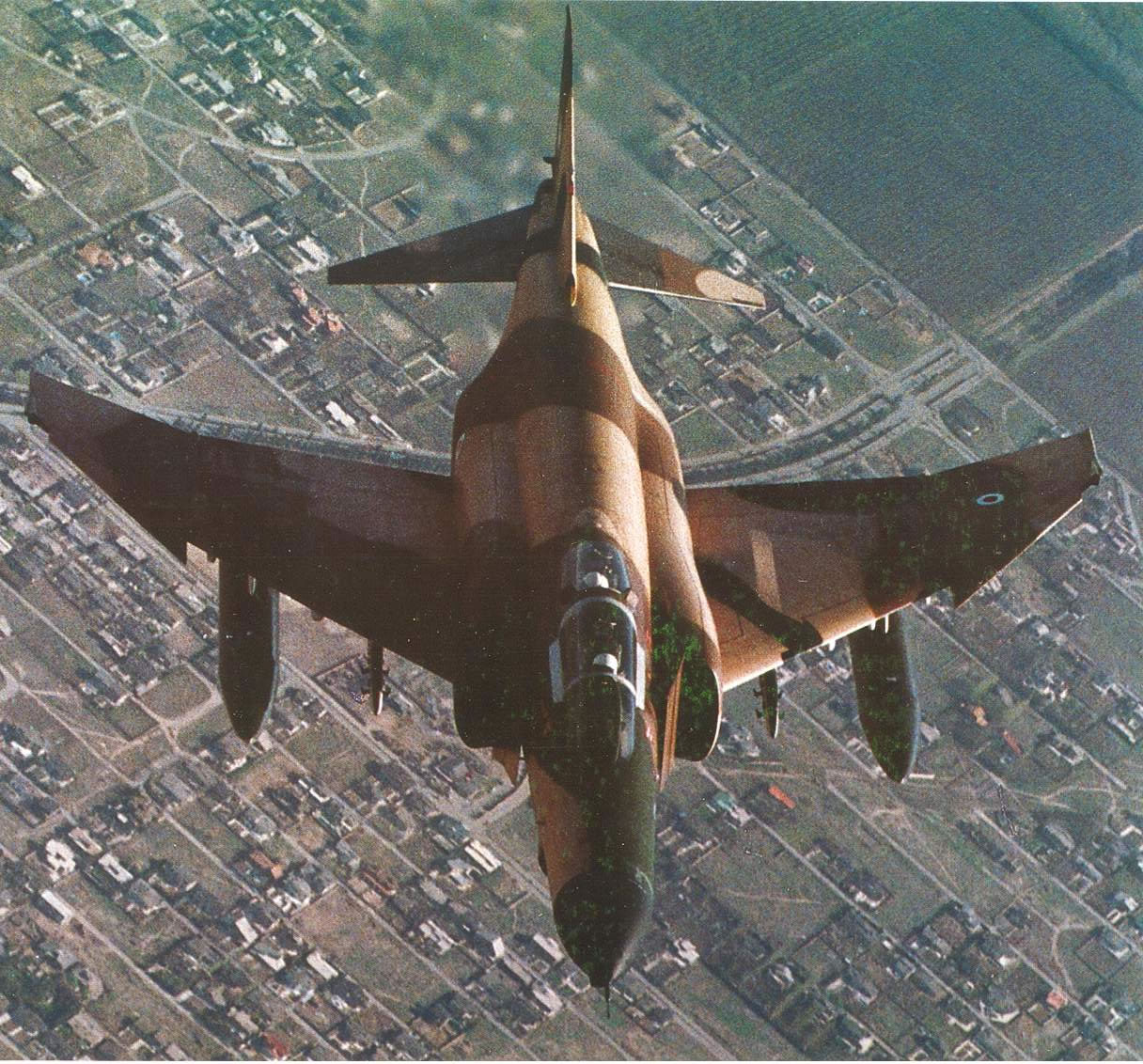The article below on the Iranian Air Force F-4 Phantom II Fighter-Bomber was originally posted in the IIAF website. Excepting one photo, all other photographs posted below are from miscellaneous sources. Kindly note that the captions/descriptions for each of the photographs are not featured in the IIAF article on the F-4 Phantom II.
==============================
The Iranian Air Force was the largest overseas operators of the F-4 Phantom before the Revolution. order were placed for 16 F-4Ds in 1967. A second batch of 16 more F-4Ds was ordered later. The first batch of F-4Ds arrived in Iran on September 8, 1968, with a total of 32 F-4Ds being ultimately delivered to the Iranian Air Force. Iranian F-4Ds were used in several unsuccessful attempts to intercept Soviet MiG-25 that were spying on Iran. The first combat use by Iran of the F-4D was in 1975 when Iran provided military assistance to the Sultan of Oman in actions against rebels. One of these F-4Ds was lost to ground fire.
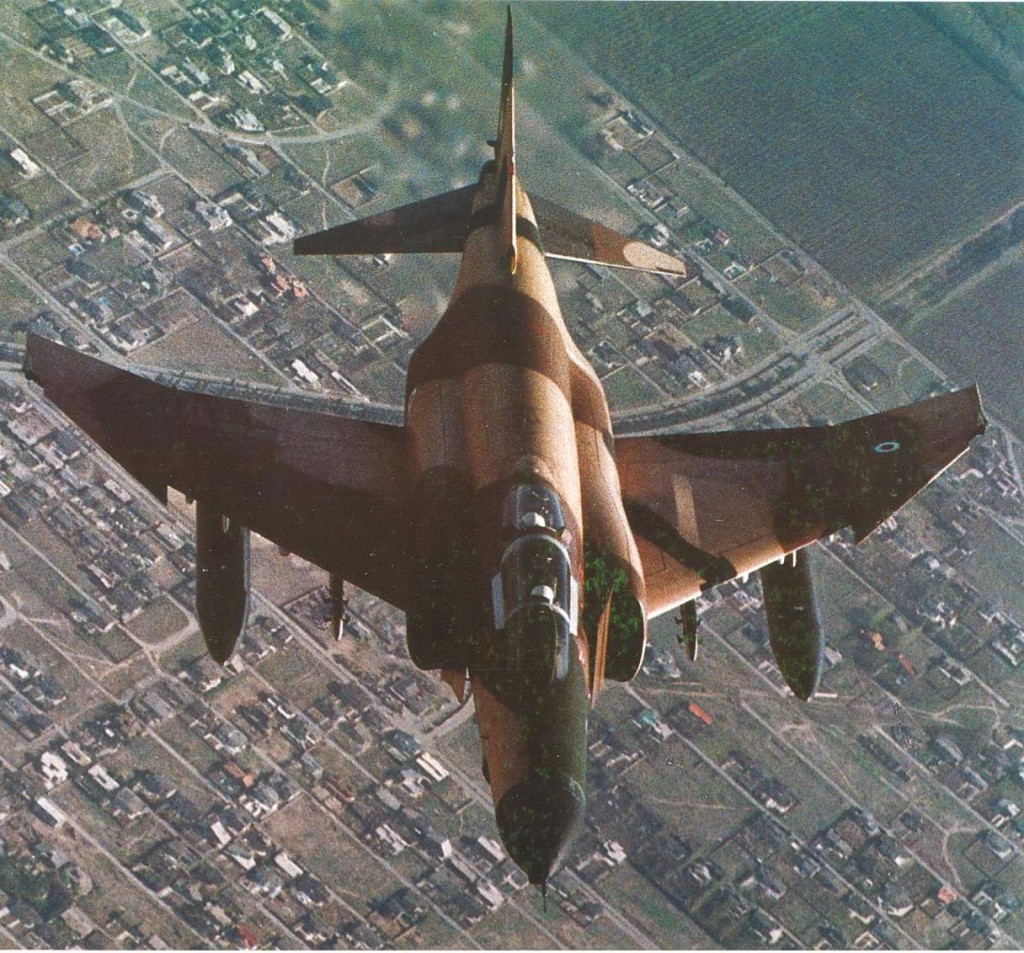 Iranian Air Force Phantom II on patrol over the skies of northern Iran (Source: IIAF). Specifications for McDonnell Douglas F-4 Phantom II are as follows: (a) Aircraft type: multi-role fighter (b) combat radius: 786 miles (c) Operational ceiling: 62000 feet (d) Maximum velocity: 1585 mph (e) Power plant: two General Electric J79-GE-17A turbojets rated at 11810 lbs thrust each dry; 17900 with afterburner. The standard weaponry of the Phantom II are as follows: (a) one M61 20mm cannon w/ 640 rounds (b) maximum ordnance 16000 lbs, including bombs, missiles, AIM-7 Sparrow, AIM-9 Sidewinder, Maverick (air to ground missile system) and AAMs.
Iranian Air Force Phantom II on patrol over the skies of northern Iran (Source: IIAF). Specifications for McDonnell Douglas F-4 Phantom II are as follows: (a) Aircraft type: multi-role fighter (b) combat radius: 786 miles (c) Operational ceiling: 62000 feet (d) Maximum velocity: 1585 mph (e) Power plant: two General Electric J79-GE-17A turbojets rated at 11810 lbs thrust each dry; 17900 with afterburner. The standard weaponry of the Phantom II are as follows: (a) one M61 20mm cannon w/ 640 rounds (b) maximum ordnance 16000 lbs, including bombs, missiles, AIM-7 Sparrow, AIM-9 Sidewinder, Maverick (air to ground missile system) and AAMs.
The government of Iran ordered 208 F-4Es and a total of 32 RF-4E from McDonnell during the early and mid-1970s. The first examples were delivered in March of 1971. A total of 177 F-4Es (plus eight F-4Es borrowed from the USA and subsequently returned) and 16 RF-4E were delivered to the Imperial Iranian Air Force between the years 1971 and 1979. However, in 1979, Revolution took over the government, and on February 28, 1979, the US government placed an embargo on further arms deliveries to Iran. The remaining 31 F-4Es and 16 RF-4E on the contract were never delivered.
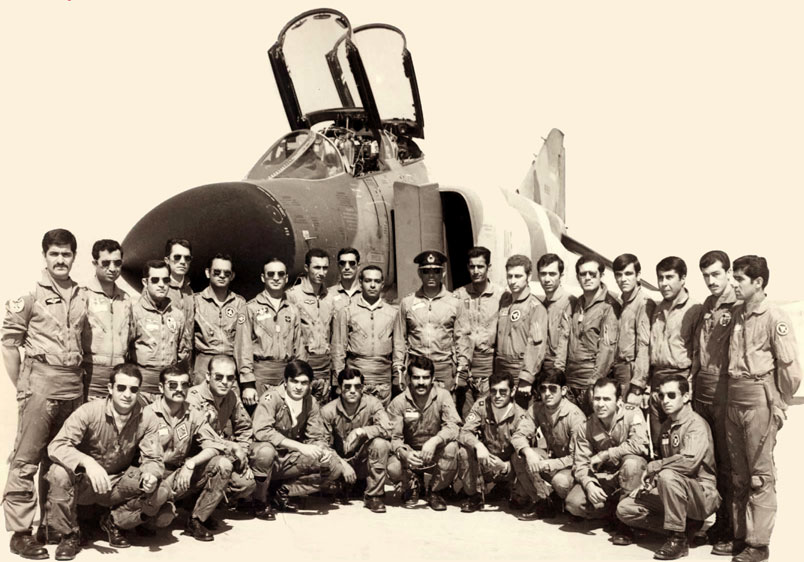 Airmen and support crews pose in front of an F-4D Phantom II in 1971 (Source: Public Domain); the above photo was taken at Shiraz’s 7th tactical fighter base.
Airmen and support crews pose in front of an F-4D Phantom II in 1971 (Source: Public Domain); the above photo was taken at Shiraz’s 7th tactical fighter base.
By the late 1970s, the Iranian Air Force was deploying its F-4 Phantoms in the following squadrons:
- 1st Tactical Air Base, Tehran (Mehrabad): Two Squadrons F- 4E, One Squadron RF- 4E Reconnaisance
- 2nd Tactical Air Base, Tabriz: Three Squadrons F-4E
- 3rd Tactical Air Base, Hamadan (Shahrokhi): Three Squadrons F-4E
- 6th Tactical Air Base, Bushehr: One Squadron F-4E, Two Squadrons F-4D
- 7th Tactical Air Base, Shiraz: One Squadrons F-4E
- 9th Tactical Air Base, Bandar Abbas: One Squadrons F-4E
- 10th Tactical Air Base , Chabahar: One Squadron F-4E
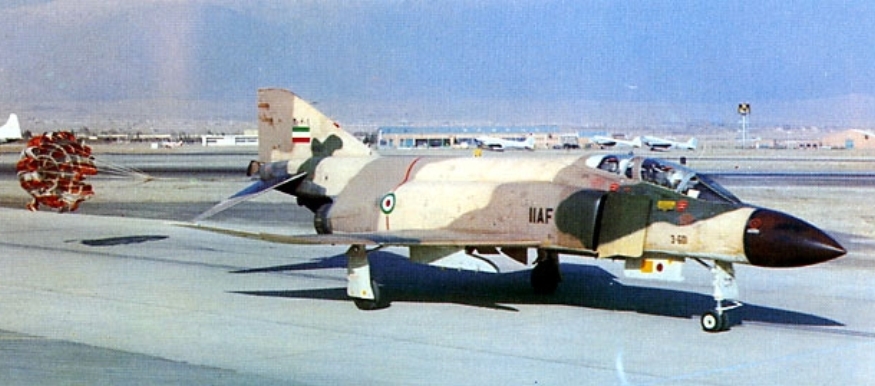 Iranian air force lands with brake chute at Mehrabad airport in the mid-late 1970s (Source: Public Domain).
Iranian air force lands with brake chute at Mehrabad airport in the mid-late 1970s (Source: Public Domain).
Onset of the Iran-Iraq War
By late February 1979, Iran had almost 223 operational Phantoms. Contrary to Western reports, F-4 squadrons managed to maintain their combat effectiveness despite widespread political upheavals and personnel purges. Technical malfunctions, often appearing during flight preparation, would reduce the flight packages, but missions were seldom aborted for this reason.
The outbreak of the Iraq-Iran War on the afternoon of September 22, 1980, resulted in the newly re-organized Islamic Republic of Iran Air Force (IRIAF) having to rely heavily on its F-4 Phantom units. This legendary veteran fighter-bomber was definitely the star of the Iranian Air Force during the eight-year war with Iraq, performing virtually every combat role, from pure fighter to deep-penetration interceptor. Phantoms were to play a key role in most of the missions far into Iraqi territory, in many cases returning to base after sustaining heavy combat damage.
The F-4’s baptism of fire during the war with Iraq was an unexpected one. The conflict began with an Iraqi air attack on six Iranian air bases and four Iranian army barracks, followed by a land offensive deep into the country at four points along a 435-mile (700km) front. This first Iraqi air attack failed due to rigid and inflexible mission planning, lack of sufficient target intelligence and the use of unsuitable General Purpose (GP) bombs. One F-4E was destroyed by having its nose section cut off in a strafing run on the ramp at the Mehrabad airport, and another F-4 base, Hamedan, also suffered some damage.
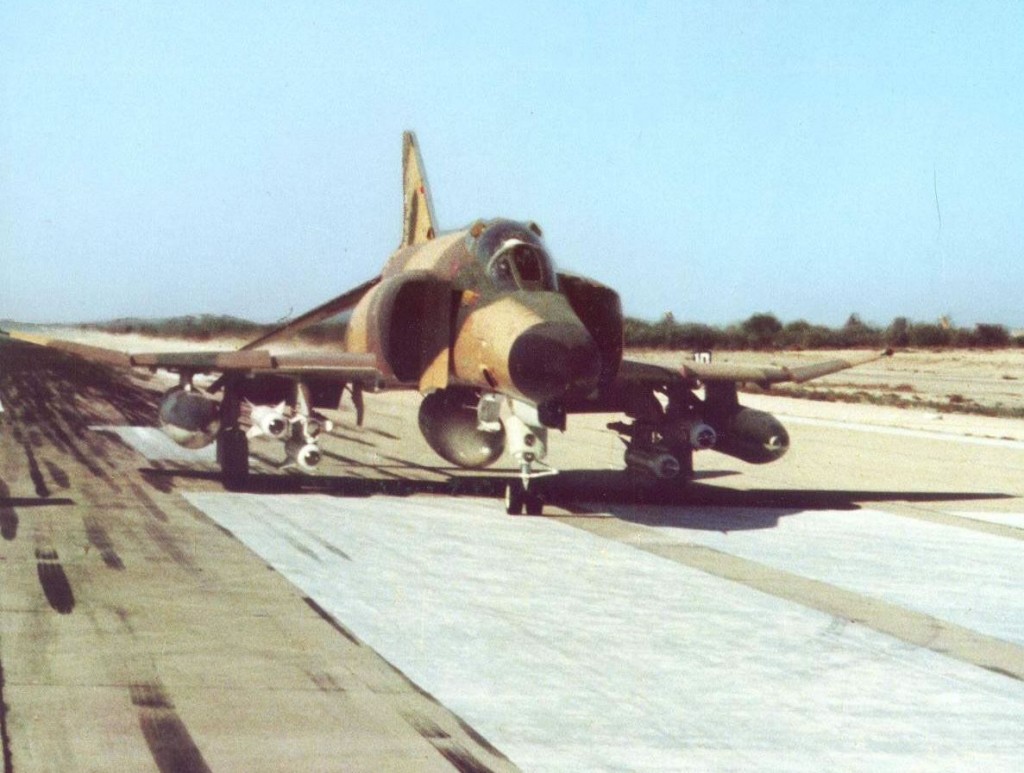 An Iranian F-4E armed with Maverick air-ground missiles preparing for take-off (Source: Public Domain). Maverick-armed phantoms wreaked considerable havoc upon Iraqi armored units during the Iran-Iraq war, especially during the operations that led to the liberation of the city of Khorramshahr on May 24, 1981; for more on this topic, see here…
An Iranian F-4E armed with Maverick air-ground missiles preparing for take-off (Source: Public Domain). Maverick-armed phantoms wreaked considerable havoc upon Iraqi armored units during the Iran-Iraq war, especially during the operations that led to the liberation of the city of Khorramshahr on May 24, 1981; for more on this topic, see here…
The first Iranian air attack into Iraq saw the successful bombing of Al-Shoibiya naval base, near the port city of Um-Al Qassr, by four F-4s from Bushehr AB, using 1,000lb (450kg) bombs. Among the targets were several anti-shipping missile batteries. This Iranian retaliation was so swift that Iraqi air defense positions had been caught by surprise right across the flight route. The next day, up to 140 Iranian fighter-bombers, including significant numbers of F-4s from Bushehr, Tehran and Hamedan, attacked a number of Iraqi air bases and military installations with almost total impunity.
These first days of the war saw other air strikes against such targets as the military installations of the Um-Al-Quasar. On one such mission a two-ship formation of F-4Es, each armed with six 750lb (340kg) GP bombs, attacked Iraqi port installations and anchored missile boats. Some 20 minutes later, an RF-4E took reconnaissance photos of the aftermath, which showed that heavy damage had been inflicted on ships and harbor installations.
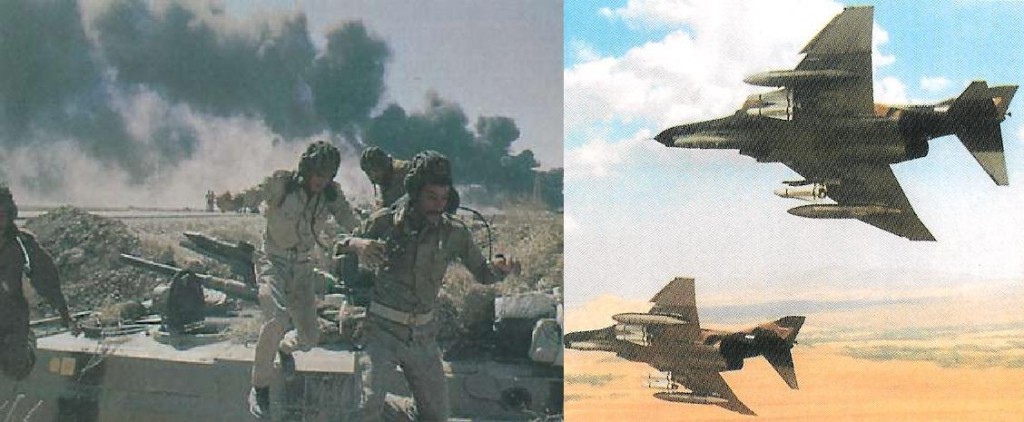 Tayyara! Tayyara! (Arabic: Airplane! Airplane!). Iraqi crew of a BMP armored personnel carrier advancing in Iran in 1980 (at left) abandon their vehicle in haste at the sound of the roaring engines of two US-made Iranian F-4E Phantoms. Iranian Phantoms (at right) were also reported to be flying just meters above ground level to fire their 20mm cannon at Iraqi tanks and armored vehicles (Picture Source at left: www.Acig.org; Picture Source at right: Farzad Bishop, Combat Aircraft 37, reproduced with permission in Iran at War: 1500-1988, 2011).
Tayyara! Tayyara! (Arabic: Airplane! Airplane!). Iraqi crew of a BMP armored personnel carrier advancing in Iran in 1980 (at left) abandon their vehicle in haste at the sound of the roaring engines of two US-made Iranian F-4E Phantoms. Iranian Phantoms (at right) were also reported to be flying just meters above ground level to fire their 20mm cannon at Iraqi tanks and armored vehicles (Picture Source at left: www.Acig.org; Picture Source at right: Farzad Bishop, Combat Aircraft 37, reproduced with permission in Iran at War: 1500-1988, 2011).
The general tactic for during such missions was to approach the target from different directions and then execute a pop-up and dive attack. On the return flight, one of the Phantoms was hit by a SAM missile on the right wing, damaging some of its systems and control surfaces; despite this, the aircraft was still flyable. However, the fuel indicators did not work and the right wing caught fire. The runways of the nearest base were still damaged from the first day’s bombing, so the crippled Phantom had to land on the unaffected part at a higher than normal speed. The tires burst and the aircraft ran off the end of the runway, after the crew had already ejected. Later, the aircraft’s wing was replaced, the first time such work had been undertaken in Iran, and it was returned to combat service.
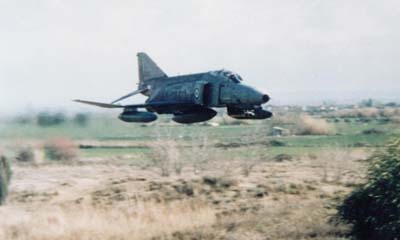 Undated photo of an Iranian Phantom II flying at very low level (Source: Persiangig).
Undated photo of an Iranian Phantom II flying at very low level (Source: Persiangig).
The first months of the war saw the Iranian Air Force making concentrated efforts to halt the Iraqi ground advance, often directly engaging tank and vehicle columns, sometimes at altitudes as low as 10-13f. (3-4m). Iraqi MiG-21 and MiG-23 fighters were used as top cover to protect their military columns heading toward Iran, and as a result there were many air-to-air encounters – with mixed results.
Attack on Habbaniyeh Airfield
A month after the Iraqi invasion, two F-4D Phantoms were sent to attack the important air base of Habbaniyeh, 70 miles (112km) west of Baghdad. The flight was equipped with ECM pods and supported by F-14 Tomcats at the border, with an RF-4E on stand-by. Aerial refueling was carried out at 13,000ft (3,960m) and the Phantoms then crossed the border to their target. One aircraft was shot down by a SAM over Baghdad and its crew taken prisoner. The second Phantom was able to evade an SA-6 missile by making an 11g turn, the missile passing across the aircraft’s tail and wing. The crew realized that it was impossible to continue the attack and resorted to a pre-determined secondary target, the Al-Bakr oil refinery.
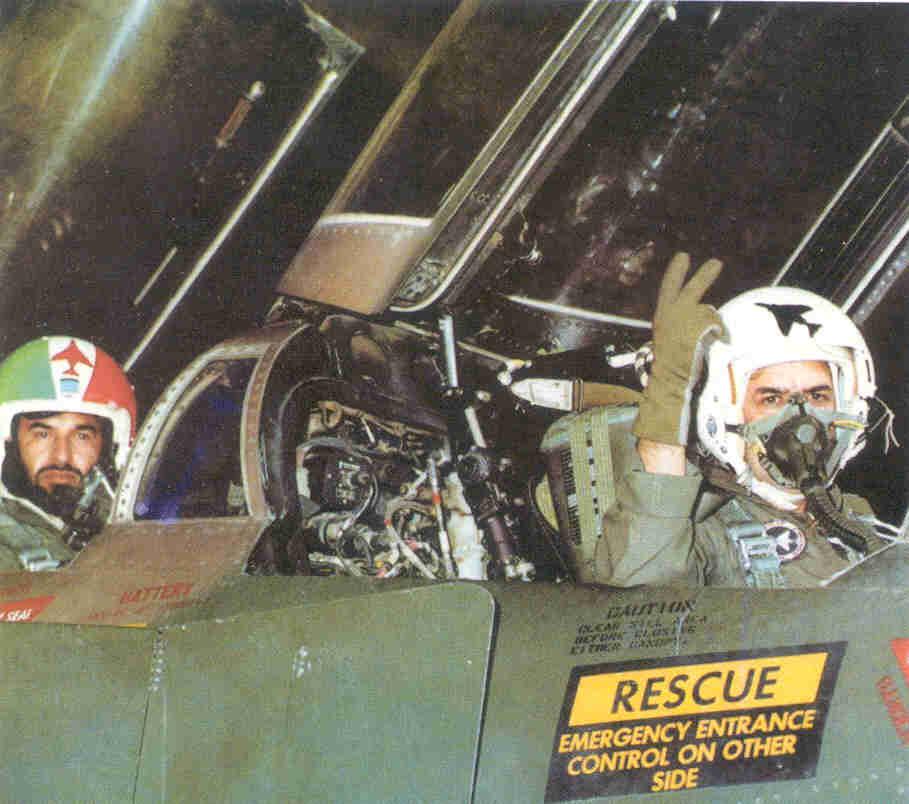 An F-4E lands after the conclusion of a successful mission during the Iran-Iraq war (date unknown). At the back-seat is war hero Lieutenant-General Abbas Babaie, who was deputy-commander of the Iranian air force at the time. Babaie also flew combat missions before being reportedly killed by Iraqi anti-aircraft fire (Picture Source: 2000, Air Forces Monthly Special: Classic Aircraft Series Number 1, “Combat over Iraq”).
An F-4E lands after the conclusion of a successful mission during the Iran-Iraq war (date unknown). At the back-seat is war hero Lieutenant-General Abbas Babaie, who was deputy-commander of the Iranian air force at the time. Babaie also flew combat missions before being reportedly killed by Iraqi anti-aircraft fire (Picture Source: 2000, Air Forces Monthly Special: Classic Aircraft Series Number 1, “Combat over Iraq”).
On the return leg, two Iraqi MiG-23s intercepted the F-4 and fired air-to-air missiles; the Phantom, flying at very low altitude, jettisoned its drop tanks and made evasive maneuvers. The MiGs finally broke off the pursuit, by this time the Phantom was very low on fuel and the crew declared an emergency, preparing to eject. Having no other alternative, the supporting stand-by Boeing 707 tanker crossed the border into Iraq to provide much-needed fuel for the starving F-4, which by that time had only 700lb. left.
During the early months of the war, the number of Iranian aircraft being shot down by Iraqi air defenses was relatively low, mainly because the operators were so inexperienced. However, this rate increased as the conflict progressed and newer systems were introduced. The flat topography of Southern Iraq meant that intruding Iranian aircraft were detected soon after entering the country. Deployment of newly-purchased low-altitude Cortile and Roland SAMs in and around Nasseriyeh AB and other military significant sites, including the strategic city of Baghubeh near Baghdad, during 1986-87, increased the capabilities of the Iraqi defenses.
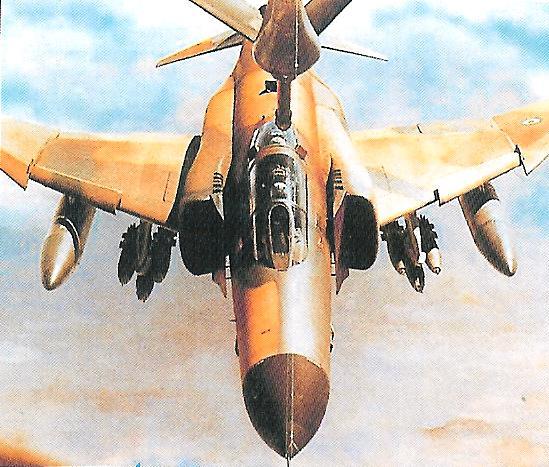 Fill her Up! This F-4 Phantom is being refueled by a Boeing 707 aerial tanker during the Iran-Iraq war. Iranian jets often refueled before going into combat missions inside Iraq. This particular Phantom is equipped with six Mk-82 bombs (equipped with Snakeye retarding fins). These allowed the Phantoms to attack ground targets at low-level and high-speed (Picture Source: Bishop & Cooper, 2003, color picture 5).
Fill her Up! This F-4 Phantom is being refueled by a Boeing 707 aerial tanker during the Iran-Iraq war. Iranian jets often refueled before going into combat missions inside Iraq. This particular Phantom is equipped with six Mk-82 bombs (equipped with Snakeye retarding fins). These allowed the Phantoms to attack ground targets at low-level and high-speed (Picture Source: Bishop & Cooper, 2003, color picture 5).
The most impenetrable air defense network in Iraq was undeniably to be found protecting Baghdad. The city was surrounded by overlapping belts of SA-2/-3/-6/-8, Roland and Cortile SAMs, radar-guided AAA and MiG-21/-23 and -25 air defense fighter interceptors.
On March 19, 1982, a high-altitude strike formation of Phantoms was bounced and engaged by an Iraqi MiG-25 Foxbat from a distance of 60 miles (97km), and was also simultaneously illuminated by air defense radars. A number of SA-2 ‘telegraph poles’ were seen passing through the formation, but all exploded at higher altitude, having been decoyed by the Phantom ECM pods. However, one F-4 was hit by an AAM fired from the Foxbat, shattering its canopy, causing the right engine to shut down, and badly damaging the fuselage. Nevertheless, the pilot managed to land his aircraft safely.
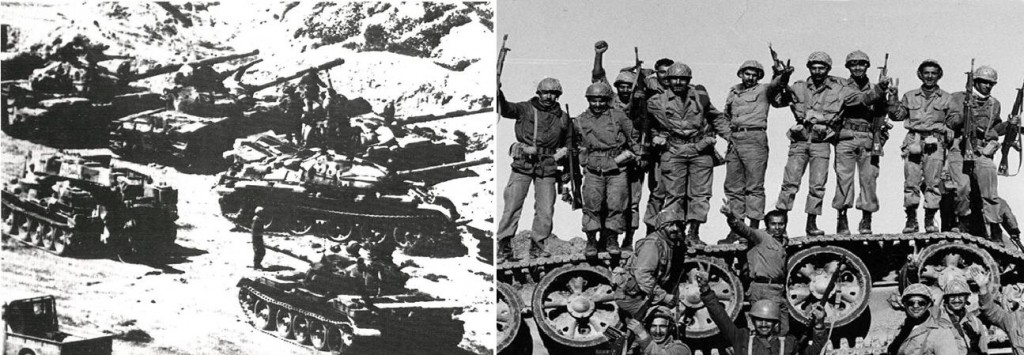 Elements of the Iraqi 12th Armored Division assemble at Fakkeh (in the Dezful area) on March 23rd 1982 to rescue remnants of the Iraqi 4th Army Corps crushed by a powerful Iranian offensive (Photo source: Steven J. Zaloga, Modern Soviet Combat Tanks, Osprey Vanguard 37, p.32). As these units deployed to attack, they were bombed and strafed by up to 95 Iranian F-4 and F-5 combat aircraft. The Iraqi 12th Armored Division was virtually eliminated. The right photo is of Iranian regular army troops atop an overturned Iraqi tank of the 12th armored division (Photo source: www.shahed.isaar.ir). Note that the vehicle has been blown upside down as a result of aerial bombardment by Iranian F-4 and F-5 combat aircraft.
Elements of the Iraqi 12th Armored Division assemble at Fakkeh (in the Dezful area) on March 23rd 1982 to rescue remnants of the Iraqi 4th Army Corps crushed by a powerful Iranian offensive (Photo source: Steven J. Zaloga, Modern Soviet Combat Tanks, Osprey Vanguard 37, p.32). As these units deployed to attack, they were bombed and strafed by up to 95 Iranian F-4 and F-5 combat aircraft. The Iraqi 12th Armored Division was virtually eliminated. The right photo is of Iranian regular army troops atop an overturned Iraqi tank of the 12th armored division (Photo source: www.shahed.isaar.ir). Note that the vehicle has been blown upside down as a result of aerial bombardment by Iranian F-4 and F-5 combat aircraft.
The Iraqis also practiced a tactic of setting up ambushes inside Iran at the border areas and pulling Iranian aircraft into the Iraqi airspace. Then Iraqi Mirage F1 or MiG-25 fighters equipped with long-range missiles would intercept them. Some Iranian F-4s were shot down using this tactic, particularly over the northern Persian Gulf. Iranian Phantoms and F-14A Tomcats also used to take advantage of such co-operative tactics; F-4s acting as the prey and F-14s as the hunters. This is contrary to previous reports in Western publications, where it had been suggested that Tomcats acted as prey for hunter Phantoms.
As for another important mission late in the war, during Operation Valfajr-10, Iranian F-4 Phantoms attacked and bombed Baghdad’s Tamuz nuclear reactors for a second time.
Weapons
Iranian Air Force used various weapons options in conjunction with its F-4 Phantom operations. They included general purpose bombs; such as 500lb. Snakeye (x12) to 750lb. (x6) and 1,000lb. (x6) GP or retard versions. AIM-7E Sparrow and AIM-9P/J Sidewinder missiles were also carried regularly for air defense and fighter escort missions. Other weapons included the AGM-65A Maverick used in conjunction with TISEO electro-optical sensor, BL 755 cluster bomb customized for low-altitude delivery, Napalm tanks and LAU-61 rocket launchers. Iranian F-4Ds also used the SUU-23 gun pods to good effect.
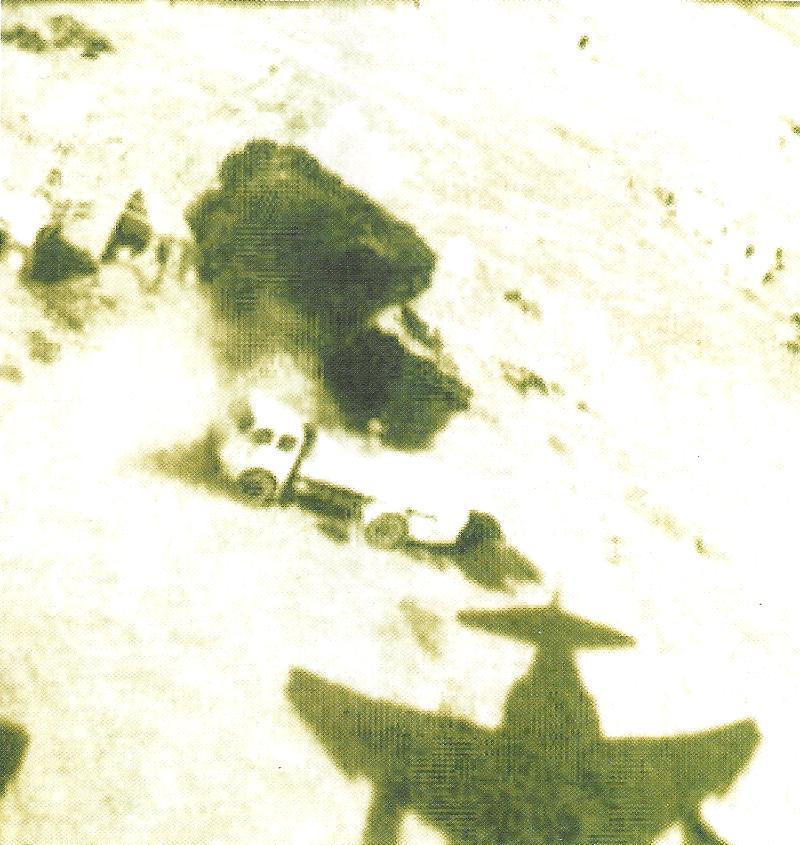 An excellent gun camera view of an F-4 Phantom attack on a rear Iraqi supply unit on May 15, 1984. The Phantom is flying very low as seen by its shadow; note explosions in background. Iran often launched successful attacks with its aircraft, but these were far too few to offset Iraq’s growing military strength on the ground and in the air (Picture Source: Farzin Nadimi, Air Forces Monthly, Classic Aircraft Series no.1, The Phantom, 2000, p.79).
An excellent gun camera view of an F-4 Phantom attack on a rear Iraqi supply unit on May 15, 1984. The Phantom is flying very low as seen by its shadow; note explosions in background. Iran often launched successful attacks with its aircraft, but these were far too few to offset Iraq’s growing military strength on the ground and in the air (Picture Source: Farzin Nadimi, Air Forces Monthly, Classic Aircraft Series no.1, The Phantom, 2000, p.79).
Two Iranian F-4D Phantoms were tasked with striking a logistically important bridge near Basreh on September 29, 1981, employing LGBs. They used a buddy-lasing tactic, one acting as target designator at about 13,000ft equipped with AVQ-9 Pave Light laser designator. The target was hit, but a short time later an SA-6 missile homed in on the designating aircraft. Both crew ejected as the aircraft was destroyed.
Escaping US Missiles
According to Iranian records, in early spring 1988 – it actually happened during the so called “Battle of the Frigates” on 18 April, 1988, an Iranian F-4E Phantom from 9th Tactical Fighter Base, Bandar-Abbas, armed with air-to-air missiles, was tasked with escorting a number of other Iranian Phantoms undertaking an unspecified strike mission within the Persian Gulf. That day, US forces in the area were also active and their warships warned off the low-flying Iranian strike package several times.
The escort Phantom was scanning the area for any hostile activity, as the other F-4s attacked their targets one after the other and then left the area. Shortly after the last attacking aircraft returned, the escort fighter’s RWR/RHAW indicated a missile lock. Moments later, a reportedly Standard Missile SM- 2ER radar guided surface-to-air missile, said to be launched from USS Wainwright, operating in the area near the Straight of Hormuz was seen coming towards the Phantom.
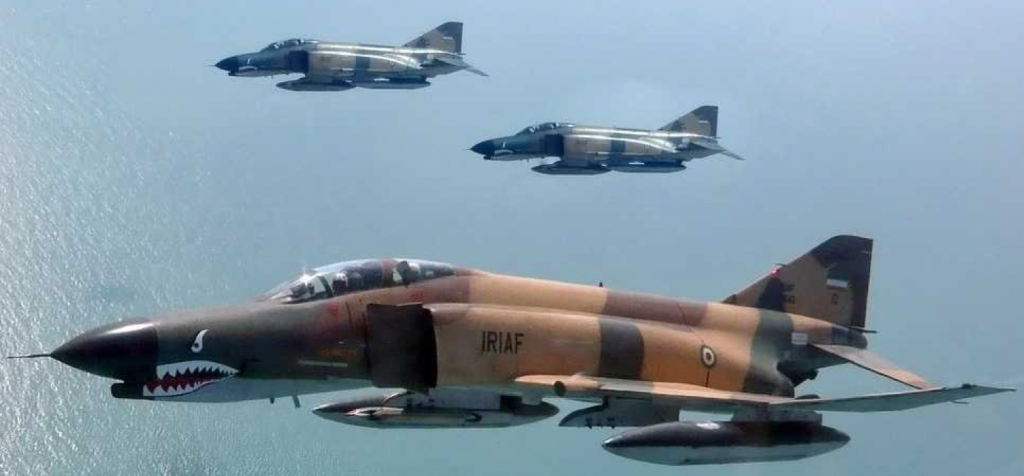 Post-war photo of a trio of Iranian Phantoms on patrol over the Persian Gulf (Source: Business Insider).
Post-war photo of a trio of Iranian Phantoms on patrol over the Persian Gulf (Source: Business Insider).
To break the radar lock, the Phantom jinked hard with maximum power, pulling a +12g turn. The missile exploded nearby, spraying the airframe with shrapnel, severing hydraulic lines and damaging the left engine. The aircraft headed towards the nearest auxiliary airstrip, but on the way it again came under attack from behind. The Phantom tried hard to break the radar lock by flying low and taking evasive action. Moment later, near the airstrip, another missile passed the right side of the F-4, hitting the water and exploding. The aircraft managed to evade this and landed on the runway. Since the airstrip lacked a barrier facility, the pilot decided to get airborne again – despite the threat from the unseen missile shooter – and headed towards the main base.
Despite partial hydraulic failure, engine problems and severe damage to the wing and fuselage, the Phantom remained controllable and finally landed in Bandar Abbas. This particular aircraft was rebuilt and returned to service after 6,000 man-hours and two and half months of work.
Phantom had been undeniably the backbone of the Iranian Air Force during the country’s eight year war with Iraq. A role that it still is fulfilling to the best of Iranian Air Force’s technical ability.
Main F-4 Operating Bases during the Iran-Iraq War
1st Fighter Base, Mehrabad, Tehran. Generating fighter and escort missions inside the border along western and south-western Iraq. It also operated as the main hub for tanker operations and aerial reconnaissance missions into Iraq and over battle fronts.
3rd Fighter Base, Hamedan (Shahrokhi, later Nojeh). Home to 31st and 32nd Fighter Wings. This base was in charge of aerial support of the western front Flying time from this base to Baghdad was 30 minutes. Due to its high sortie generation rate, Nojeh came under constant enemy bombing.
4th Fighter Base, Dezful (Vahdati) (mostly F-5). Because of its proximity to the Iraqi border, this base was constantly under artillery attacks and bombing.
6th Fighter Base, Bushehr. This base was mainly tasked with attacks on shipping in the northern and central parts of the Persian Gulf, escort and support of Iranian naval operations, and strike missions against Iraqi ports and naval vessels.
9th Fighter Base, Bandar Abbas. Mainly in charge of attacking shipping in the Persian Gulf, aircraft from this base monitored foreign military activities in and around the Strait of Hormuz, and provided escort and support of Iranian naval assets.
10th Fighter Base, Chabahar. This particular air base was in charge of monitoring the Sea of Oman and the Arabian Sea.
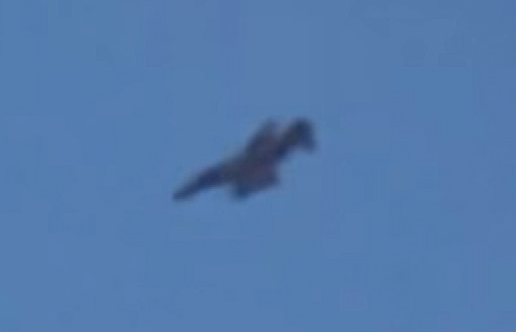 The Old Warhorse in action in late 2014: the venerable Phantom attacking ISIS positions in support of the Kurds; this photo is from a film report by the Al-Jazeera network (Source: Al-Jazeera, December 2, 2014).
The Old Warhorse in action in late 2014: the venerable Phantom attacking ISIS positions in support of the Kurds; this photo is from a film report by the Al-Jazeera network (Source: Al-Jazeera, December 2, 2014).

